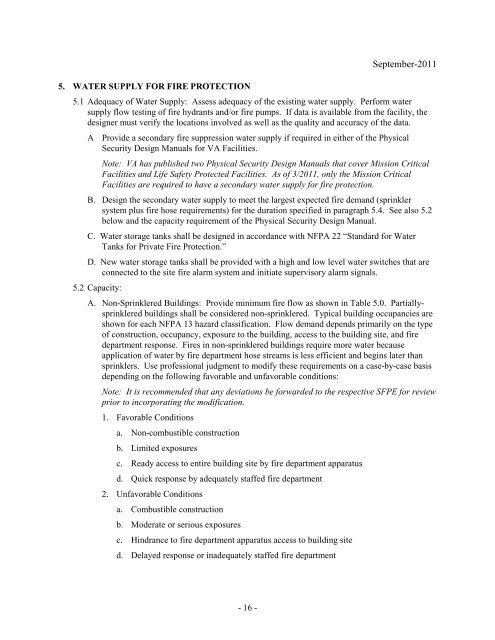Fire Protection Design Manual - Office of Construction and Facilities ...
Fire Protection Design Manual - Office of Construction and Facilities ...
Fire Protection Design Manual - Office of Construction and Facilities ...
Create successful ePaper yourself
Turn your PDF publications into a flip-book with our unique Google optimized e-Paper software.
September-2011<br />
5. WATER SUPPLY FOR FIRE PROTECTION<br />
5.1 Adequacy <strong>of</strong> Water Supply: Assess adequacy <strong>of</strong> the existing water supply. Perform water<br />
supply flow testing <strong>of</strong> fire hydrants <strong>and</strong>/or fire pumps. If data is available from the facility, the<br />
designer must verify the locations involved as well as the quality <strong>and</strong> accuracy <strong>of</strong> the data.<br />
A Provide a secondary fire suppression water supply if required in either <strong>of</strong> the Physical<br />
Security <strong>Design</strong> <strong>Manual</strong>s for VA <strong>Facilities</strong>.<br />
Note: VA has published two Physical Security <strong>Design</strong> <strong>Manual</strong>s that cover Mission Critical<br />
<strong>Facilities</strong> <strong>and</strong> Life Safety Protected <strong>Facilities</strong>. As <strong>of</strong> 3/2011, only the Mission Critical<br />
<strong>Facilities</strong> are required to have a secondary water supply for fire protection.<br />
B. <strong>Design</strong> the secondary water supply to meet the largest expected fire dem<strong>and</strong> (sprinkler<br />
system plus fire hose requirements) for the duration specified in paragraph 5.4. See also 5.2<br />
below <strong>and</strong> the capacity requirement <strong>of</strong> the Physical Security <strong>Design</strong> <strong>Manual</strong>.<br />
C. Water storage tanks shall be designed in accordance with NFPA 22 “St<strong>and</strong>ard for Water<br />
Tanks for Private <strong>Fire</strong> <strong>Protection</strong>.”<br />
D. New water storage tanks shall be provided with a high <strong>and</strong> low level water switches that are<br />
connected to the site fire alarm system <strong>and</strong> initiate supervisory alarm signals.<br />
5.2 Capacity:<br />
A. Non-Sprinklered Buildings: Provide minimum fire flow as shown in Table 5.0. Partiallysprinklered<br />
buildings shall be considered non-sprinklered. Typical building occupancies are<br />
shown for each NFPA 13 hazard classification. Flow dem<strong>and</strong> depends primarily on the type<br />
<strong>of</strong> construction, occupancy, exposure to the building, access to the building site, <strong>and</strong> fire<br />
department response. <strong>Fire</strong>s in non-sprinklered buildings require more water because<br />
application <strong>of</strong> water by fire department hose streams is less efficient <strong>and</strong> begins later than<br />
sprinklers. Use pr<strong>of</strong>essional judgment to modify these requirements on a case-by-case basis<br />
depending on the following favorable <strong>and</strong> unfavorable conditions:<br />
Note: It is recommended that any deviations be forwarded to the respective SFPE for review<br />
prior to incorporating the modification.<br />
1. Favorable Conditions<br />
a. Non-combustible construction<br />
b. Limited exposures<br />
c. Ready access to entire building site by fire department apparatus<br />
d. Quick response by adequately staffed fire department<br />
2. Unfavorable Conditions<br />
a. Combustible construction<br />
b. Moderate or serious exposures<br />
c. Hindrance to fire department apparatus access to building site<br />
d. Delayed response or inadequately staffed fire department<br />
- 16

















